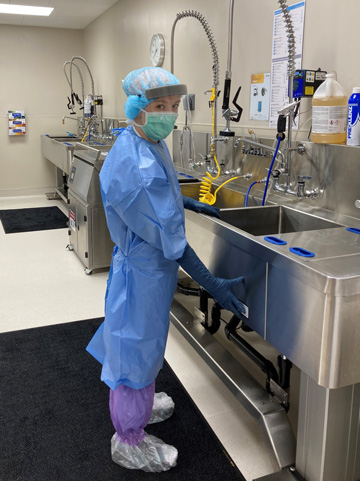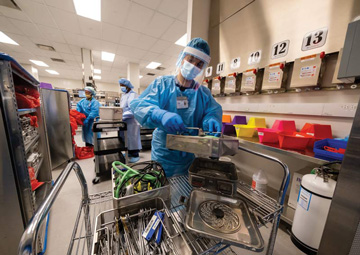Making paper recordkeeping a thing of the past at this medical center helped streamline workflow, standardize processes and eliminate chances for errors.
CTracing a heritage back over 119 years to Sioux Falls Hospital, Sanford Health has become an institution known for its stability and health care excellence.1 In recent years, its facilities have experienced unprecedented growth – and with that growth came increased demands on its staff and physicians, especially in reprocessing and sterilization work, pushing its current perioperative staff to their limits.
To find relief from sterilization and associated administrative tasks, Sanford Medical Center Bismarck (Sanford) turned to the ASP Ecosystem, consisting of STERRAD® Systems with ALLClear® Technology, the STERRAD VELOCITY® BI System, and ASP ACCESS® Technology, as a source of leverage to streamline their low temperature sterilization operation through its powerful workflow automation.
Perioperative Services Management at the Sanford Bismarck Sterile Processing Department (SPD) began a committed, concerted effort to remove steps, tasks and processes that had the potential for productivity-draining errors. The genesis of this concrete effort was a decision to institute an instrument tracking system that enabled the standardization of instrument reprocessing recordkeeping. By scanning of barcodes or marks through a terminal or mobile interface, a substantial source of errors was eliminated.
The instrument tracking system, however, only eliminated some of the opportunities for manual entry errors. With the automation available through Sanford’s installation of the ASP Ecosystem, manual recordkeeping for its low temperature sterilizers was eliminated.
Prior to the availability of the ASP Ecosystem, Sanford depended on thermal paper-based printed records from their low temperature sterilizer systems or manual data logging to computer-based databases to maintain records of their instrument and device sterilization. This paper-based recordkeeping was an outdated process, which increased opportunities for error.
Brandi Everding, SPD Manager for Sanford, recounts the now-retired process of manually recording low temperature sterilizer loads. "When your load was complete, you took printouts and scanned them and then attached [the image] to that specific load", said Ms. Everding.
Ms. Everding noted that this process always held the potential for error: "When you pulled a printout into a load, [it was possible] you might scan the printout into the wrong load."
Now that the hospital has implemented the complete the ASP Ecosystem, it has made manual recordkeeping for compliance an automated activity, resulting in measurable workflow efficiencies.
Missing Data and Manual Recordkeeping: It Happens to Everyone
Before the arrival of the ASP Ecosystem at Sanford, manual logging activity was frequently noted to have mixed results. Ms. Everding recounts the logging activities and their challenges: "I can tell you that, before the ASP Ecosystem was in place, I noticed not all the logging information was entered. It was missing one thing or the other, whether that be the lot number, the load number, the start time of the BI, or something else. That definitely caused some frustration, and it was something we constantly had to bring up with our staff. And [with the ASP Ecosystem], that has improved 100 percent."
With a busy low temperature sterilization schedule, Ms. Everding says, "We run a lot of low temp loads, for a facility our size. We moved a number of scopes out of HLD and into sterilization." This change resulted in the department running an average of 25 low temperature sterilization loads per day.
Since the department includes a BI with every sterilizer load, 25 BIs have to be run each day as well. This generated as many as 50 low-temperature sterilization load logging tasks each day, representing 50 interruptions, 50 opportunities for error and 150.6 minutes of lost productivity.
Perhaps more frustrating than missing log information was the non-stop requirement for logging tasks such as the completion of a low-temperature sterilizer load or a BI read. These logging tasks at Sanford may have been the cause of distractions and interruptions, on average one every 10 minutes or less per 8-hour day shift that can cause problems of their own.
Ironically, while manual recordkeeping tasks were meant to document compliance through mandated logging after each sterilizer run, logging activities at Sanford became new opportunities for errors. Regardless of whether a technician gathered the load print outs and recorded a load when it was complete or performed the logging tasks at the end of the day, recordkeeping required time that can now be better spent on tasks at Sanford.
Standardizing Recordkeeping: Automated is the New Standard
In addition to decreasing distractions and interruptions associated with manual recordkeeping, Sanford had another big intention for the ASP Ecosystem: standardization of its recordkeeping through automation.
Sanford began by interconnecting all of their instrument reprocessing systems with their instrument tracking system, CensiTrac™. This ensured that one logging method was used for reprocessing activities, netting significant savings in time and potential errors. Having their STERRAD VELOCITY® Readers connected as part of the ASP Ecosystem has been beneficial to the institution as well. Initiating a new BI is straightforward; the STERRAD VELOCITY® Reader allows the operator to scan a code on the vial and instantly checks to ensure the correct BI type is being used, the BI is not expired and that the BI has never been incubated before.
The results of all BI reads are reported to the operator as "Pass" or "Fail", all complete with pictures, to reduce the opportunity for misunderstandings or errors. Ms. Everding notes, "The STERRAD VELOCITY® Reader literally walks you through, so that’s something that’s a huge advantage when you look at having travelers or new technicians. Again, it really takes away chances for error."
Finally, ASP ACCESS® Technology provides all of the STERRAD® Sterilizer with ALLClear® Technology and STERRAD VELOCITY® Reader records in report form. While some of the information is also available in their instrument tracking system, ASP ACCESS® Technology also offers notifications if any system becomes disconnected from the network through its web application. "It even sent me an email when I had unplugged the old [system] and was getting the new ones set up… it's definitely working to its potential," says Ms. Everding.
Note: For more information, please go to www.asp.com.
References:
1. Renshaw, Eric (2012) Forgotten Sioux Falls. Charleston, South Carolina, Arcadia Pub, pp. 26.
 CREDIT: UCF Lake Nona Medical Center
CREDIT: UCF Lake Nona Medical Center.svg?sfvrsn=be606e78_3)


.svg?sfvrsn=56b2f850_5)